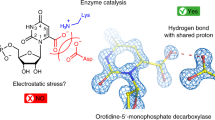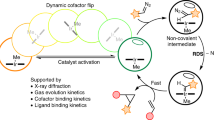Abstract
Inosine monophosphate dehydrogenase (IMPDH) and guanosine monophosphate reductase (GMPR) belong to the same structural family, share a common set of catalytic residues and bind the same ligands. The structural and mechanistic features that determine reaction outcome in the IMPDH and GMPR family have not been identified. Here we show that the GMPR reaction uses the same intermediate E-XMP* as IMPDH, but in this reaction the intermediate reacts with ammonia instead of water. A single crystal structure of human GMPR type 2 with IMP and NADPH fortuitously captures three different states, each of which mimics a distinct step in the catalytic cycle of GMPR. The cofactor is found in two conformations: an 'in' conformation poised for hydride transfer and an 'out' conformation in which the cofactor is 6 Å from IMP. Mutagenesis along with substrate and cofactor analog experiments demonstrate that the out conformation is required for the deamination of GMP. Remarkably, the cofactor is part of the catalytic machinery that activates ammonia.
This is a preview of subscription content, access via your institution
Access options
Subscribe to this journal
Receive 12 print issues and online access
$259.00 per year
only $21.58 per issue
Buy this article
- Purchase on Springer Link
- Instant access to full article PDF
Prices may be subject to local taxes which are calculated during checkout






Similar content being viewed by others
References
Glasner, M.E., Gerlt, J.A. & Babbitt, P.C. Evolution of enzyme superfamilies. Curr. Opin. Chem. Biol. 10, 492–497 (2006).
Soskine, M. & Tawfik, D.S. Mutational effects and the evolution of new protein functions. Nat. Rev. Genet. 11, 572–582 (2010).
Zalatan, J.G. & Herschlag, D. The far reaches of enzymology. Nat. Chem. Biol. 5, 516–520 (2009).
Nagano, N., Orengo, C.A. & Thornton, J.M. One fold with many functions: the evolutionary relationships between TIM barrel families based on their sequences, structures and functions. J. Mol. Biol. 321, 741–765 (2002).
Gerlt, J.A. & Raushel, F.M. Evolution of function in (β/α)8-barrel enzymes. Curr. Opin. Chem. Biol. 7, 252–264 (2003).
Wise, E.L. & Rayment, I. Understanding the importance of protein structure to nature's routes for divergent evolution in TIM barrel enzymes. Acc. Chem. Res. 37, 149–158 (2004).
Lo Conte, L., Brenner, S.E., Hubbard, T.J., Chothia, C. & Murzin, A.G. SCOP database in 2002: refinements accommodate structural genomics. Nucleic Acids Res. 30, 264–267 (2002).
Orengo, C.A. et al. CATH—a hierarchic classification of protein domain structures. Structure 5, 1093–1108 (1997).
Anantharaman, V., Aravind, L. & Koonin, E.V. Emergence of diverse biochemical activities in evolutionarily conserved structural scaffolds of proteins. Curr. Opin. Chem. Biol. 7, 12–20 (2003).
Taylor, J.S. & Raes, J. Duplication and divergence: the evolution of new genes and old ideas. Annu. Rev. Genet. 38, 615–643 (2004).
Bergthorsson, U., Andersson, D.I. & Roth, J.R. Ohno's dilemma: evolution of new genes under continuous selection. Proc. Natl. Acad. Sci. USA 104, 17004–17009 (2007).
Conant, G.C. & Wolfe, K.H. Turning a hobby into a job: how duplicated genes find new functions. Nat. Rev. Genet. 9, 938–950 (2008).
Innan, H. & Kondrashov, F. The evolution of gene duplications: classifying and distinguishing between models. Nat. Rev. Genet. 11, 97–108 (2010).
Khersonsky, O. & Tawfik, D.S. Enzyme promiscuity: a mechanistic and evolutionary perspective. Annu. Rev. Biochem. 79, 471–505 (2010).
Hedstrom, L. IMP dehydrogenase: structure, mechanism and inhibition. Chem. Rev. 109, 2903–2928 (2009).
Weber, G., Nakamura, H., Natsumeda, Y., Szekeres, T. & Nagai, M. Regulation of GTP biosynthesis. Adv. Enzyme Regul. 32, 57–69 (1992).
Gan, L., Petsko, G.A. & Hedstrom, L. Crystal structure of a ternary complex of Tritrichomonas foetus inosine 5′-monophosphate dehydrogenase: NAD+ orients the active site loop for catalysis. Biochemistry 41, 13309–13317 (2002).
Prosise, G.L. & Luecke, H. Crystal structures of Tritrichomonas foetus inosine monophosphate dehydrogenase in complex with substrate, cofactor and analogs: a structural basis for the random-in ordered-out kinetic mechanism. J. Mol. Biol. 326, 517–527 (2003).
Colby, T.D., Vanderveen, K., Strickler, M.D., Markham, G.D. & Goldstein, B.M. Crystal structure of human type II inosine monophosphate dehydrogenase: implications for ligand binding and drug design. Proc. Natl. Acad. Sci. USA 96, 3531–3536 (1999).
Riera, T.V., Wang, W., Josephine, H.R. & Hedstrom, L. A kinetic alignment of orthologous inosine-5′-monophosphate dehydrogenases. Biochemistry 47, 8689–8696 (2008).
Gan, L. et al. The immunosuppressive agent mizoribine monophosphate forms a transition state analog complex with IMP dehydrogenase. Biochemistry 42, 857–863 (2003).
Guillén Schlippe, Y.V., Riera, T.V., Seyedsayamdost, M.R. & Hedstrom, L. Substitution of the conserved Arg-Tyr dyad selectively disrupts the hydrolysis phase of the IMP dehydrogenase reaction. Biochemistry 43, 4511–4521 (2004).
Guillén Schlippe, Y.V. & Hedstrom, L. Is Arg418 the catalytic base required for the hydrolysis step of the IMP dehydrogenase reaction? Biochemistry 44, 11700–11707 (2005).
Min, D. et al. An enzymatic atavist revealed in dual pathways for water activation. PLoS Biol. 6, e206 (2008).
Li, J. et al. Crystal structure of human guanosine monophosphate reductase 2 (GMPR2) in complex with GMP. J. Mol. Biol. 355, 980–988 (2006).
Spector, T., Jones, T.E. & Miller, R.L. Reaction mechanism and specificity of human GMP reductase. Substrates, inhibitors, activators, and inactivators. J. Biol. Chem. 254, 2308–2315 (1979).
Deng, Y. et al. NADPH-dependent GMP reductase isoenzyme of human (GMPR2). Expression, purification, and kinetic properties. Int. J. Biochem. Cell Biol. 34, 1035–1050 (2002).
Martinelli, L.K. et al. Recombinant Escherichia coli GMP reductase: kinetic, catalytic and chemical mechanisms, and thermodynamics of enzyme-ligand binary complex formation. Mol. Biosyst. 7, 1289–1305 (2011).
Bellamacina, C.R. The nicotinamide dinucleotide binding motif: a comparison of nucleotide binding proteins. FASEB J. 10, 1257–1269 (1996).
Hughes, R., Magee, E.A. & Bingham, S. Protein degradation in the large intestine: relevance to colorectal cancer. Curr. Issues Intest. Microbiol. 1, 51–58 (2000).
Roberts, R.E., Lienhard, C.I., Gaines, C.G., Smith, J.M. & Guest, J.R. Genetic and molecular characterization of the guaC-nadC-aroP region of Escherichia coli K-12. J. Bacteriol. 170, 463–467 (1988).
Macpherson, I.S. et al. The structural basis of Cryptosporidium-specific IMP dehydrogenase inhibitor selectivity. J. Am. Chem. Soc. 132, 1230–1231 (2010).
Talfournier, F., Pailot, A., Stines-Chaumeil, C. & Branlant, G. Stabilization and conformational isomerization of the cofactor during the catalysis in hydrolytic ALDHs. Chem. Biol. Interact. 178, 79–83 (2009).
Minegishi, S. & Mayr, H. How constant are Ritchie′s “constant selectivity relationships”? A general reactivity scale for n-, pi-, and sigma-nucleophiles. J. Am. Chem. Soc. 125, 286–295 (2003).
Musa-Aziz, R., Chen, L.M., Pelletier, M.F. & Boron, W.F. Relative CO2/NH3 selectivities of AQP1, AQP4, AQP5, AmtB, and RhAG. Proc. Natl. Acad. Sci. USA 106, 5406–5411 (2009).
Ji, R. & Brune, A. Nitrogen mineralization, ammonia accumulation, and emission of gaseous NH3 by soil-feeding termites. Biogeochemistry 78, 267–283 (2006).
van Ham, R.C. et al. Reductive genome evolution in Buchnera aphidicola. Proc. Natl. Acad. Sci. USA 100, 581–586 (2003).
Hansen, A.K. & Moran, N.A. Aphid genome expression reveals host-symbiont cooperation in the production of amino acids. Proc. Natl. Acad. Sci. USA 108, 2849–2854 (2011).
Zahnle, K., Schaefer, L. & Fegley, B. Earth's earliest atmospheres. Cold Spring Harb. Perspect. Biol. 2, a004895 (2010).
Kim, H.S., Mittenthal, J.E. & Caetano-Anolles, G. MANET: tracing evolution of protein architecture in metabolic networks. BMC Bioinformatics 7, 351 (2006).
Zhang, R. et al. Differential signatures of bacterial and mammalian IMP dehydrogenase enzymes. Curr. Med. Chem. 6, 537–543 (1999).
Leslie, A.G.W. Recent changes to the MOSFLM package for processing film and image plate data. Joint CCP4 and ESF-EAMCB Newsl. Protein Crystallogr. 26, (1992).
Kabsch, W. Evaluation of single-crystal X-ray diffraction data from a position-sensitive detector. J. Appl. Crystallogr. 21, 916–924 (1988).
Murshudov, G.N., Vagin, A.A. & Dodson, E.J. Refinement of macromolecular structures by the maximum-likelihood method. Acta Crystallogr. D Biol. Crystallogr. 53, 240–255 (1997).
Emsley, P. & Cowtan, K. Coot: model-building tools for molecular graphics. Acta Crystallogr. D Biol. Crystallogr. 60, 2126–2132 (2004).
Chen, V.B. et al. MolProbity: all-atom structure validation for macromolecular crystallography. Acta Crystallogr. D Biol. Crystallogr. 66, 12–21 (2010).
Frisch, M.J. et al. Gaussian 03, Revision C.02. (ed. Gaussian, I.) (2004).
Brady, K. & Abeles, R.H. Inhibition of chymotrypsin by peptidyl trifluoromethyl ketones: determinants of slow-binding kinetics. Biochemistry 29, 7608–7617 (1990).
Zhang, R. et al. Characteristics and crystal structure of bacterial inosine-5′-monophosphate dehydrogenase. Biochemistry 38, 4691–4700 (1999).
Pettersen, E.F. et al. UCSF Chimera—a visualization system for exploratory research and analysis. J. Comput. Chem. 25, 1605–1612 (2004).
Acknowledgements
We thank S. Andrews at the University of Sheffield for supplying the pUC plasmid carrying the E. coli K12 GMPR gene. We also are grateful for construction of pET28a GMPR by I.S. MacPherson. We also thank the staff at BESSY (Berlin, Germany) for support at beamline BL14.1. This work was supported by the US National Institutes of Health (NIH) GM54403 (L.H.) and by grants from the Swedish Research Council (P.N. and P.S.), the Swedish Cancer Society (P.N.), the Wenner-Gren Foundations (P.S.) and the Swedish Foundation for Strategic Research (P.S.). The Q-Tof Ultima mass spectrometer at the University of Illinois was purchased in part with a grant from the National Science Foundation, Division of Biological Infrastructure (DBI-0100085). Molecular graphics images were produced using the University of California, San Fransisco (UCSF) Chimera package from the Resource for Biocomputing, Visualization, and Informatics at the UCSF (supported by NIH P41 RR001081). The Structural Genomics Consortium is a registered charity (no. 1097737) that receives funds from the Canadian Institutes for Health Research, the Canadian Foundation for Innovation, Genome Canada through the Ontario Genomics Institute, GlaxoSmithKline, Karolinska Institutet, the Knut and Alice Wallenberg Foundation, the Ontario Innovation Trust, the Ontario Ministry for Research and Innovation, Merck & Co., Inc., the Novartis Research Foundation, the Swedish Agency for Innovation Systems, the Swedish Foundation for Strategic Research and the Wellcome Trust.
Author information
Authors and Affiliations
Contributions
G.C.P., D.R.G., C.T.S. and L.H. conceived and designed the mechanism experiments. G.C.P., D.R.G. and C.T.S. performed and analyzed these experiments. P.S., H.S. and P.N. conceived and designed the structural experiments. P.S., H.S., S.F. and P.K. performed these experiments, and P.S., H.S., P.K., P.N. and H.E. analyzed the data. R.S. and F.H. conceived, performed and analyzed DFT computations. L.H., G.C.P., H.E., P.S. and P.N. wrote the paper.
Corresponding authors
Ethics declarations
Competing interests
The authors declare no competing financial interests.
Supplementary information
Supplementary Text and Figures
Supplementary Methods and Supplementary Results (PDF 770 kb)
Rights and permissions
About this article
Cite this article
Patton, G., Stenmark, P., Gollapalli, D. et al. Cofactor mobility determines reaction outcome in the IMPDH and GMPR (β-α)8 barrel enzymes. Nat Chem Biol 7, 950–958 (2011). https://doi.org/10.1038/nchembio.693
Received:
Accepted:
Published:
Issue Date:
DOI: https://doi.org/10.1038/nchembio.693
This article is cited by
-
IMP/GTP balance modulates cytoophidium assembly and IMPDH activity
Cell Division (2018)
-
Quantum-chemical approach to determining the high potency of clorgyline as an irreversible acetylenic monoamine oxidase inhibitor
Journal of Neural Transmission (2013)



